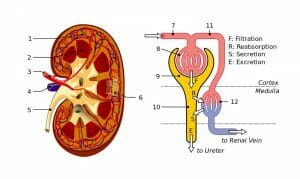Tubular Secretion Definition
Tubular secretion is one of many steps in the process of filtering blood to produce liquid waste in the form of urine. Within the excretory system of many organisms, this is important for both waste removal and acid-base balance. This step is usually used to remove drugs, toxins and poisons, or other natural compounds in excessive amounts (such as potassium (K+), hydrogen (H+), and urea).
Location of Tubular Secretion
In humans, and other vertebrates, tubular secretion occurs in the kidneys, where the blood is filtered in specialized structures known as nephrons. These structures consist of a long tubule surrounded by extensive capillaries. The secreted substances come from the blood in peritubular capillaries and pass through the interstitial fluid before going through the wall of the tubule (known as the transport epithelium) into the inside of the tubule (known as the lumen). Different aspects of secretion occur in the proximal or distal portions of each tubule, but not in the region between known as the loop of Henle.

In the image above, a simplified drawing of a nephron (right) within the kidney (left) is shown. Secretion is indicated by the letter S, which involves specific waste products moving from the blood in the capillaries (in red and purple) into the nephron tubule (in yellow).
Mechanism of Tubular Secretion
Many substances filtered in the kidney move between the different regions of the nephron via diffusion and osmotic gradients, but tubular secretion occurs via active transport. Several different types of transporter proteins exist in the membrane of the tubular cells making up the transport epithelium. These transporters move different substances into the tubular lumen, with energy in the form of ATP required to run them. Different types of transporters are found in different regions of the tubule, which partially determines the function of those regions.
Drugs and toxins are secreted into the proximal tubule. In both proximal and distal tubule regions, H+ is also transported to maintain ideal pH. One example of a transporter important for this is the Na+ – H+ exchanger (NHE3). Within the distal tubule, K+ is also transported at varied levels depending on the amount in excess of the body’s need. Ultimately, these secreted substances make their way into urine and are removed from the body.
Quiz
1. Which substances are transported via tubular secretion?
A. Hydrogen ions
B. Potassium ions
C. Toxins
D. All of the above
References
- Berkhin, E.B., & Humphreys, M.H. (2001). Regulation of renal tubular secretion of organic compounds. Kidney International, 59, 17-30.
- Golembieska, E., & Ciechanowski, K. (2012). Renal tubular acidosis – underrated problem? Acta Biochimica Polonica, 59(2), 213-217.
